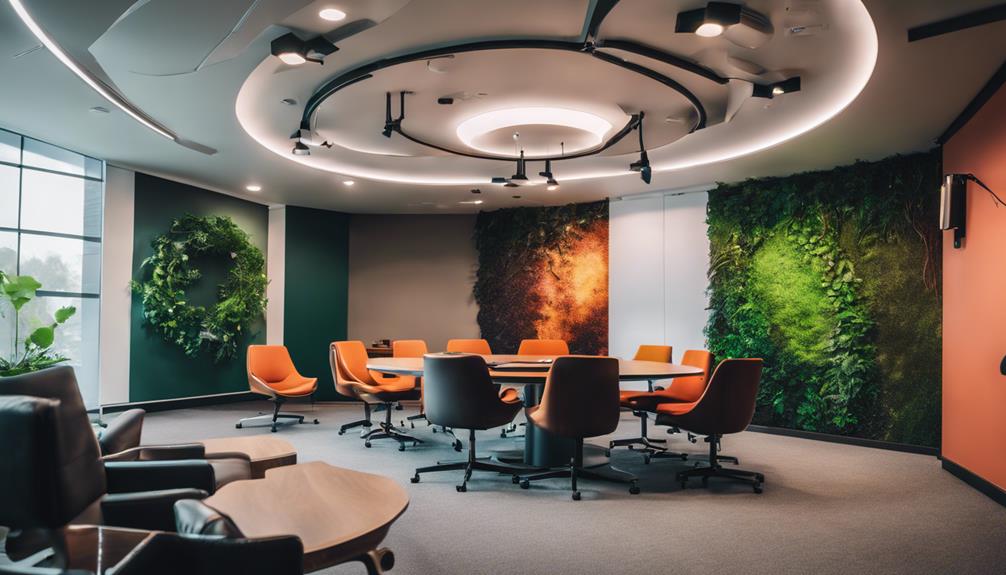You're witnessing a revolution in real estate project management, fueled by tech advancements and hybrid work models. Virtual platforms enable seamless collaboration, while cloud-based solutions streamline workflows and document sharing. Embracing flexibility helps you adapt to diverse team dynamics and current market trends. Networking enhances your visibility and access to new opportunities, while sustainability initiatives drive property value and align with eco-conscious demands. By prioritizing technology and connections, you can thrive amidst industry changes. Keep exploring to uncover strategies and insights that can elevate your project management approach.
Key Takeaways
- Leveraging cloud-based solutions enhances collaboration and streamlines workflows, making project management more efficient in real estate.
- Embracing data analytics tools provides critical insights for informed decision-making and strategic planning in property projects.
- Adopting hybrid work models improves flexibility, allowing teams to balance in-office presence with remote work for increased productivity.
- Focusing on sustainability in renovations aligns with market demands and enhances property value while achieving NetZero goals.
Impact of Technology on Project Management
The pandemic has accelerated the adoption of technology in project management, transforming how you conduct meetings, interviews, and events.
Virtual platforms have become your go-to tools, allowing you to collaborate effortlessly regardless of location. Video conferencing has replaced in-person gatherings, enabling real-time communication that keeps your projects on track.
You can share documents and updates instantly through cloud-based solutions, streamlining workflows and enhancing productivity. Project management software helps you monitor progress, assign tasks, and manage deadlines effectively.
Additionally, data analytics tools empower you to make informed decisions by providing insights into project performance. Embracing these technologies not only improves efficiency but also prepares you for the evolving landscape of project management in a post-pandemic world.
Navigating Hybrid Work Models
Navigating hybrid work models requires flexibility in project management strategies to accommodate diverse team dynamics and evolving workplace preferences. You'll need to balance in-office presence with remote work, ensuring everyone stays connected and productive. Consider these key aspects to enhance your approach:
| Aspect | Benefits | Challenges |
|---|---|---|
| Communication | Improved collaboration | Misalignment across teams |
| Technology Utilization | Streamlined processes | Overdependence on tools |
| Team Engagement | Boosted morale | Maintaining inclusivity |
| Workspace Design | Greater adaptability | Balancing comfort and functionality |
| Performance Metrics | Clear accountability | Difficulty in measuring outcomes |
Networking for Professional Growth

Building a strong professional network is essential for unlocking new opportunities and fostering growth in the ever-evolving real estate industry.
You'll find that engaging with industry peers not only enhances your visibility but also opens doors to collaborations and problem-solving partnerships.
Join organizations like CoreNet and attend diverse events to expand your connections.
Be proactive—reach out, introduce yourself, and share insights.
These relationships can lead to mentorship, referrals, and insider knowledge that keeps you ahead of the curve.
Remember, networking isn't just about what you can gain; it's also about how you can contribute to others' success.
Cultivating these connections can significantly impact your career trajectory and help you navigate challenges in the real estate landscape.
Current Market Trends
Current market trends in commercial real estate are shifting rapidly, with a significant increase in the availability of sublease spaces and growing interest in adaptive reuse projects.
You'll notice millions of square feet of sublease options, particularly in cities like Boston, where furnished spaces are becoming more appealing. As businesses adapt, there's a strong push to convert traditional office spaces into residential or lab environments, reflecting evolving needs.
The industrial market is also booming, especially in Tough Tech and electric vehicle sectors. This dynamic landscape emphasizes the importance of flexibility in your project management strategies, ensuring you're well-equipped to respond to these ongoing transformations and capitalize on emerging opportunities in the real estate sector.
Renovation and Sustainability Initiatives

As you explore new opportunities in commercial real estate, the focus on renovation and sustainability initiatives is becoming increasingly vital for adapting spaces to meet modern demands.
You'll find that these projects not only enhance property value but also align with eco-conscious trends.
Here are four key aspects to consider:
- NetZero Goals: Prioritize achieving carbon neutrality in your renovations.
- Space Decommissioning: Focus on minimizing waste and landfill contributions during project phases.
- Vendor Collaboration: Partner with suppliers for furniture and equipment reuse, donation, and recycling.
- Market Demand: Respond to growing client requests for sustainable features in properties.
Personal Drive in Project Management
Fueled by personal passion and strong networks, project managers can navigate industry challenges more effectively and drive successful outcomes. Your enthusiasm not only inspires your team but also fosters collaboration, leading to innovative solutions.
When you tap into your personal connections, you gain access to diverse perspectives and resources that can elevate your projects. This drive for excellence creates an energized environment where creativity thrives, helping you tackle obstacles head-on.
Additionally, your commitment to the mission strengthens relationships with clients and stakeholders, reinforcing trust and loyalty. Embracing personal motivation and leveraging your network is essential for adapting to the evolving real estate landscape, ensuring you remain ahead in a competitive market while achieving your project goals.
Future Insights and Adaptations

Looking ahead, staying adaptable and informed will be key to navigating the evolving landscape of real estate project management. Looking ahead, staying adaptable and informed will be key to navigating the evolving landscape of real estate project management. As sustainability and technological advancements reshape the industry, professionals must also address facility management challenges and solutions to ensure operational efficiency and tenant satisfaction. Emphasizing collaboration and leveraging data-driven insights will play a crucial role in overcoming obstacles and driving long-term success in this dynamic field.
As you embrace future changes, consider these essential areas:
- Embrace Technology: Leverage advanced tools for virtual collaboration and project tracking.
- Prioritize Sustainability: Integrate eco-friendly practices in your projects to meet growing client demands.
- Flexibility in Design: Adapt office spaces for hybrid work models to accommodate diverse workforce needs.
- Strengthen Networks: Engage in professional groups for collaboration, learning, and problem-solving opportunities.
Conclusion
As you embrace the future of real estate project management, remember that adaptability is your strongest ally.
Like a river carving its path, you'll navigate the currents of technology, hybrid work, and sustainability.
Stay connected through networking, harnessing every opportunity to grow.
With each renovation project, let your passion fuel creativity and collaboration.
By staying ahead of trends and embracing change, you're not just managing projects; you're shaping the very landscape of the industry.










